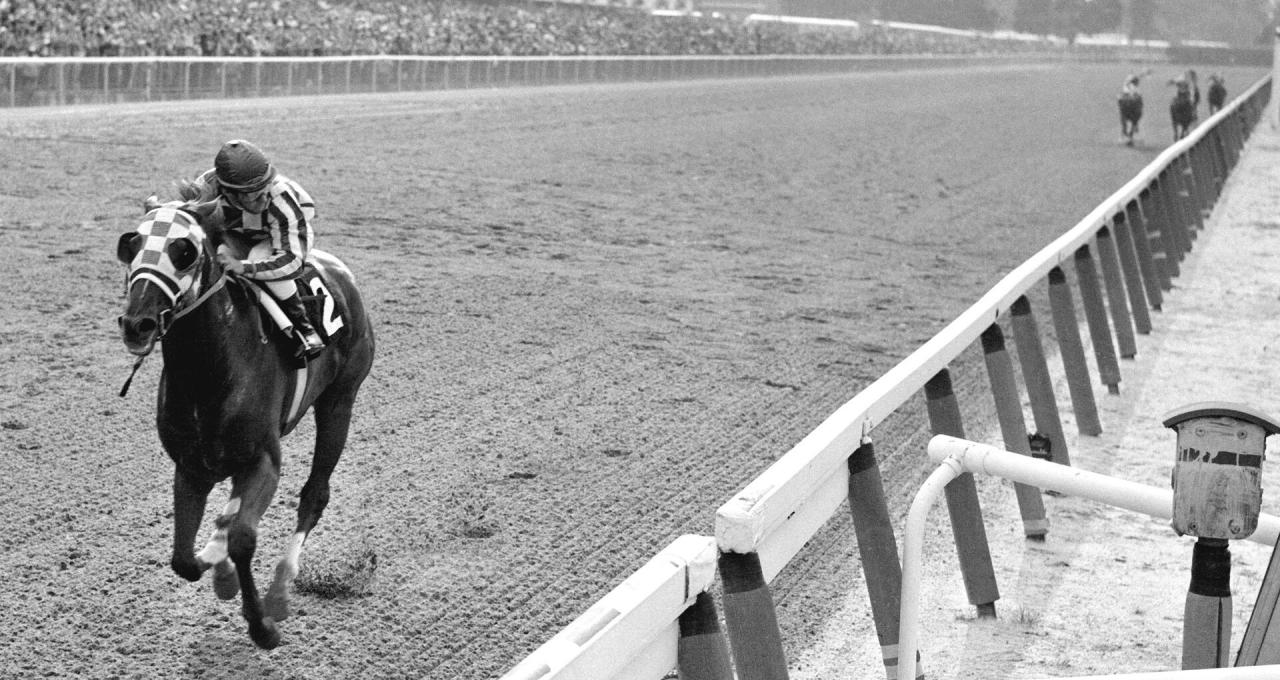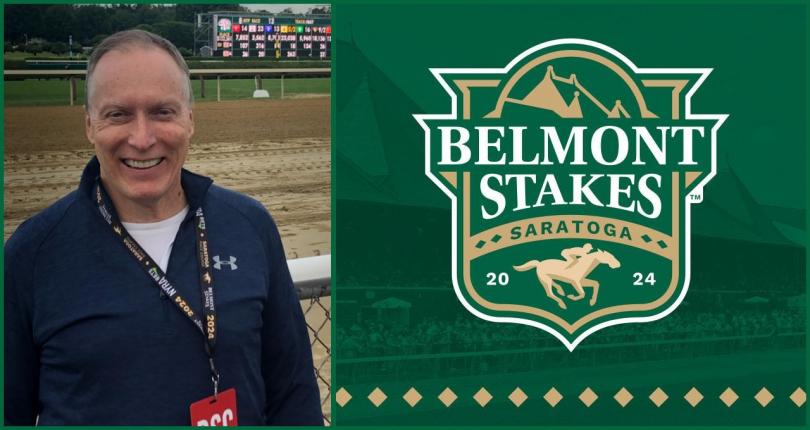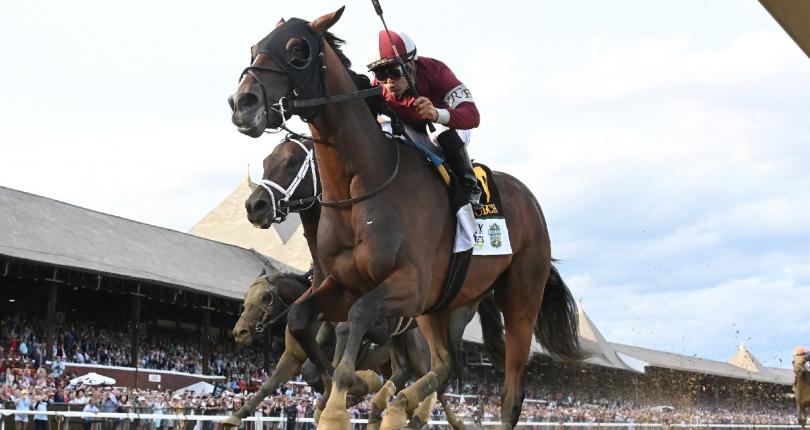
Secretariat
by Francis LaBelle Jr.
Paid banners below are not related to Belmont Stakes Ticket Sales.
Of all the great horses that have made the pilgrimage to Belmont Park since its Opening Day on Thursday, May 4, 1905, only one horse impressed upon Belmont Park the stamp of immortality.
Secretariat.
His 31-length romp into the realm of legend in the 1973 Belmont Stakes was ideal for Belmont Park, North America’s largest racetrack. Such a huge stage demanded a gargantuan performance, and fittingly, “Big Red” delivered. Under jockey Ron Turcotte, Secretariat moved like “a tremendous machine,” according to track announcer Chick Anderson, at full throttle, racing not against his four rivals but against the ages.
The image of Turcotte looking back for any sign of competition, a delirious crowd on its feet and Secretariat looking like he could effortlessly go around once again after setting the still-unbroken record of 2:24 for the mile and one-half is indelible in the minds of Thoroughbred racing’s fans.
Secretariat’s glorious triumph happened in the 105th running of the Belmont Stakes, 25 years after Citation had won his Triple Crown. Four years later, in 1977, Seattle Slew won the Belmont Stakes and the Triple Crown. It was his ninth straight victory and he remains the only undefeated horse to win the Triple Crown. He then lost his next start, the Swaps Stakes, at Hollywood Park, to end his three-year-old campaign.
As the oldest and longest leg of racing’s Triple Crown for three-year-olds, the Belmont Stakes is yet another reason why Belmont Park has achieved its regal status in the sporting world. Originally run at Jerome Park in 1867, the Belmont Stakes would become the true “Test of the Champion.”
The 1970s produced three Triple Crown winners – Secretariat, Seattle Slew and Affirmed – and spoiled a lot of racing fans. They made it look easy, but only 11 horses have won the Triple Crown, the last being Affirmed in 1978, whose classic battles with Alydar rank as among the all-time great sports rivalries. The Belmont Stakes has stopped 19 Kentucky Derby and Preakness winners from joining that elite group of Triple Crown winners, the latest victim being Big Brown.
The 2008 Belmont Stakes was widely expected to be a coronation for Big Brown, especially when his main competition, undefeated Japanese entry Casino Drive, scratched the morning of the race. After dominating performances in the Kentucky Derby and Preakness, 94,476 fans gathered at Belmont Park expecting to see history made.
Instead, 38-1 longshot Da’ Tara led from gate to wire, winning by 5 ¼ lengths. Big Brown was eased at the top of the stretch by jockey Kent Desormeaux and finished last. At the time, there was seemingly no explanation – the horse was not injured, the quarter crack in his left front hoof that had sidelined him from training for a few days the week of the race didn’t seem to factor in. Later, a photo was released that appeared to show a loose right hind shoe and while hotly debated, the shoe was never definitively proven to have affected the horse’s performance. Meanwhile, trainer Nick Zito’s reputation as a giant slayer was cemented – not only did Zito condition Da’ Tara, he had also trained 36-1 longshot Birdstone who thwarted Smarty Jones’ 2004 Triple Crown bid.
That drama and excitement would be part of Belmont Park’s fabric was established from the start.
In 1902, a syndicate headed by August Belmont II and former Secretary of the Navy William C. Whitney sought land on Long Island to build a bigger more elaborate track than the one in use, old Morris Park. They found what they were looking for on the border of Queens County and Nassau County. This bit of land, known as Foster’s Meadow when it was purchased in 1647 by Christopher and Thomas Foster, had been called Elmont since 1882. That name, selected over Farmer’s Valley and Belle Font, was chosen at a town meeting in order to establish a post office.
By September, the syndicate had acquired more than 650 acres for its new track, and the biggest purchase was the $125,000 that went for the Tudor-Gothic Manice Mansion, known as “Oatlands” and owned by New York Attorney William De Forest Manice.
With an estimated crowd of more than 40,000 in attendance for the 3 p.m. first-race post on May 4, 1905, the tone of Belmont Park was set when August Belmont II’s Blandy, at 7-1, held off 100-1 Oliver Cromwell to win the $1,500 Belmont Inaugural. Later that day, as the temperature continued to drop, James R. Keene’s Sysonby came onto the track to compete in the 14th running of the Metropolitan Handicap. He had won all but one of his five starts as a two-year-old and this was his three-year-old debut. Also in this field was the talented filly Beldame, another of Belmont’s charges and the favored entry that day.
Sysonby got unexpected competition from 20-1 longshot Race King, and they battled through the stretch, hitting the finish line at the same time to record the first dead-heat in track history.
So Opening Day at Belmont Park featured longshot upsets and a dead heat. This was only the beginning.
By 1908, Belmont Park had produced a bona fide star in Colin, who would retire that year undefeated in 15 starts, seven of which came at Belmont Park. He would remain the only undefeated major Thoroughbred for 80 years.
Man o’ War was Belmont Park’s next big star. He launched his fabled career at Belmont Park in 1919 with a pair of wins, and then closed out his season with a victory in the Belmont Futurity. At 3, he won the Withers, the Belmont Stakes, the Lawrence Realization and the Jockey Club Stakes. He never lost at Belmont Park.
Kentucky Derby winner Zev defeated Papyrus by five lengths in a match race on October 20, 1923. It was the first time that a Kentucky Derby winner had defeated an Epsom Derby winner, and their duel brought in an estimated crowd of 45,000, which was the largest for a match race in 100 years.
A true horse for the Belmont Park course was Citation, the 1948 Triple Crown winner. He had won the Futurity at Belmont Park as a two-year-old, and then won the Belmont Stakes in his 11th start at 3. That same year – he made 20 starts as a three-year-old, losing once -- he won the Sysonby Mile, Jockey Club Gold Cup and Gold Cup Stakes at Belmont Park. Citation would finish out his career on the West Coast, but retired undefeated in five starts at Belmont Park. There would not be another Triple Crown winner again until Secretariat a quarter of a century later.
Ruffian came on the scene in 1974, and immediately grabbed the world’s attention by winning her debut on May 22 by 15 lengths. Wherever she went, she brought crowds and the fastest filly ever never failed to delight.
But, on July 6, 1975, in a one-turn, 1¼-mile match race with Kentucky Derby winner Foolish Pleasure at Belmont Park, Ruffian broke down.
Attempts to save her life were thwarted because every time she came out of anesthesia, she would kick and shatter the cast on her injured leg. Eventually, after all avenues to save her life were exhausted, she was euthanized and buried in Belmont Park’s infield.
One of the great races no longer run at Belmont Park was the Marlboro Cup, and one of the great performances ever in that race or at the track was turned in by Forego in 1976.
The great weight carrier lost the 1975 Marlboro Cup by a head to Wajima, to whom he spotted 10 pounds while carrying 129 pounds. It wasn’t going to be easier this time, carrying 137 pounds.
Forego looked like a goner in the Marlboro Cup. He broke from post 10, and then steadily lost ground, as Honest Pleasure, toting 119 pounds, took a happy, uncontested lead into the lane. But Hall of Fame jockey Bill Shoemaker got Forego going and he rallied to win the 10-furlong race by a head in 2:00.
Seattle Slew, in 1977, became the only undefeated horse to win the Triple Crown, and only the Affirmed-Alydar rivalry one year later could have topped that show.
Horses have always been the true stars of racing and Belmont Park, but humans have come up big, too. James Rowe and George Martin Odom remain the only two men in history to have won the Belmont Stakes as both a jockey and trainer. Odom won the 1904 Belmont Stakes on Delhi (for trainer Rowe) and the 1938 Belmont Stakes as the trainer of Pasteurized.
Rowe, one of the forgotten stars of the game, rode back-to-back Belmont Stakes winners Joe Daniels and Springbok in 1872 and ’73, and would win eight Belmont Stakes as a trainer with George Kinnery (1883), Panique (1884), Commando (1901), Delhi (1904), Peter Pan (1907), Colin (1908), Sweep (1910) and Prince Eugene (1913).
On Oct. 27, 1962, 20-1 Beau Purple defeated eventual five-time Horse of the Year Kelso in the Man o’ War for Hall of Fame trainer H. Allen “The Giant Killer” Jerkens. It was the last stakes race at “old” Belmont Park -- on April 10, 1963, engineering surveys by two separate firms determined that Belmont Park’s grandstand, which was atop the roof, was unsafe and would have to come down. The New York Racing Association, then chaired by James Cox Brady, opted to build a bigger, better track. On May 20, 1968, the “new” Belmont Park opened at a cost of $30.7 million.
Perhaps the most impressive human record at Belmont Park remains the five straight Belmont Stakes winners saddled by the late Hall of Fame trainer Woody Stephens. They were Conquistador Cielo (1982), Caveat (1983), Swale (1984), Crème Fraiche (1985) and Danzig Connection (1986). On June 5, 1992, the New York Racing Association unveiled “Woody’s Corner” in the first floor clubhouse at Belmont Park. There, trophies from his Belmont conquests surround a giant portrait of Woody seated aboard his beloved pony, “Rex.”
Until his death on August 22, 1998, Stephens wore a watch that was a present from New York Yankees Hall of Famer Joe DiMaggio, saying that, like his own major league record 56-game hitting streak, Stephens’ five straight Belmont Stakes wins was a record not likely to be broken.
In more recent times, Hall of Fame trainer Shug McGaughey turned in the greatest day ever at Belmont Park on October 16, 1993. That Breeder’s Cup Preview Day, he saddled seven starters and won with six of them, including five stakes races: the Jockey Club Gold Cup (Miner’s Mark); Kelso Handicap (Lure); Frizette (Heavenly Prize); Beldame (Dispute) and the Lawrence Realization (Strolling Along).
As for jockeys, Hall of Famer Jorge Velasquez boasts two perfect days at Belmont Park. He was 6-for-6 on July 9, 1981 and 5-for-5 on June 2, 1980. Jeff Fell also went 5-for-5 on June 19, 1980. Clarence Kummer, Laverne Fator, Earl Sande, Sonny Workman, Johnny Loftus, Eddie Arcaro, Angel Cordero Jr., Braulio Baeza, Julie Krone and Jerry Bailey also called Belmont Park home during their careers.
Still, of all the players and of all the performances at Belmont Park over the years, none touches that of Secretariat.
He remains alone at the head of the pack, just as he was on that special day, June 9, 1973.








 Gambling Problems? The New York Racing Association encourages responsible wagering. If gambling is a problem for you or someone you care about, help is available 24 hours a day. Scan here to talk with someone now about your gambling. Or call toll-free 1-877-8-HOPE-NY.
Gambling Problems? The New York Racing Association encourages responsible wagering. If gambling is a problem for you or someone you care about, help is available 24 hours a day. Scan here to talk with someone now about your gambling. Or call toll-free 1-877-8-HOPE-NY.